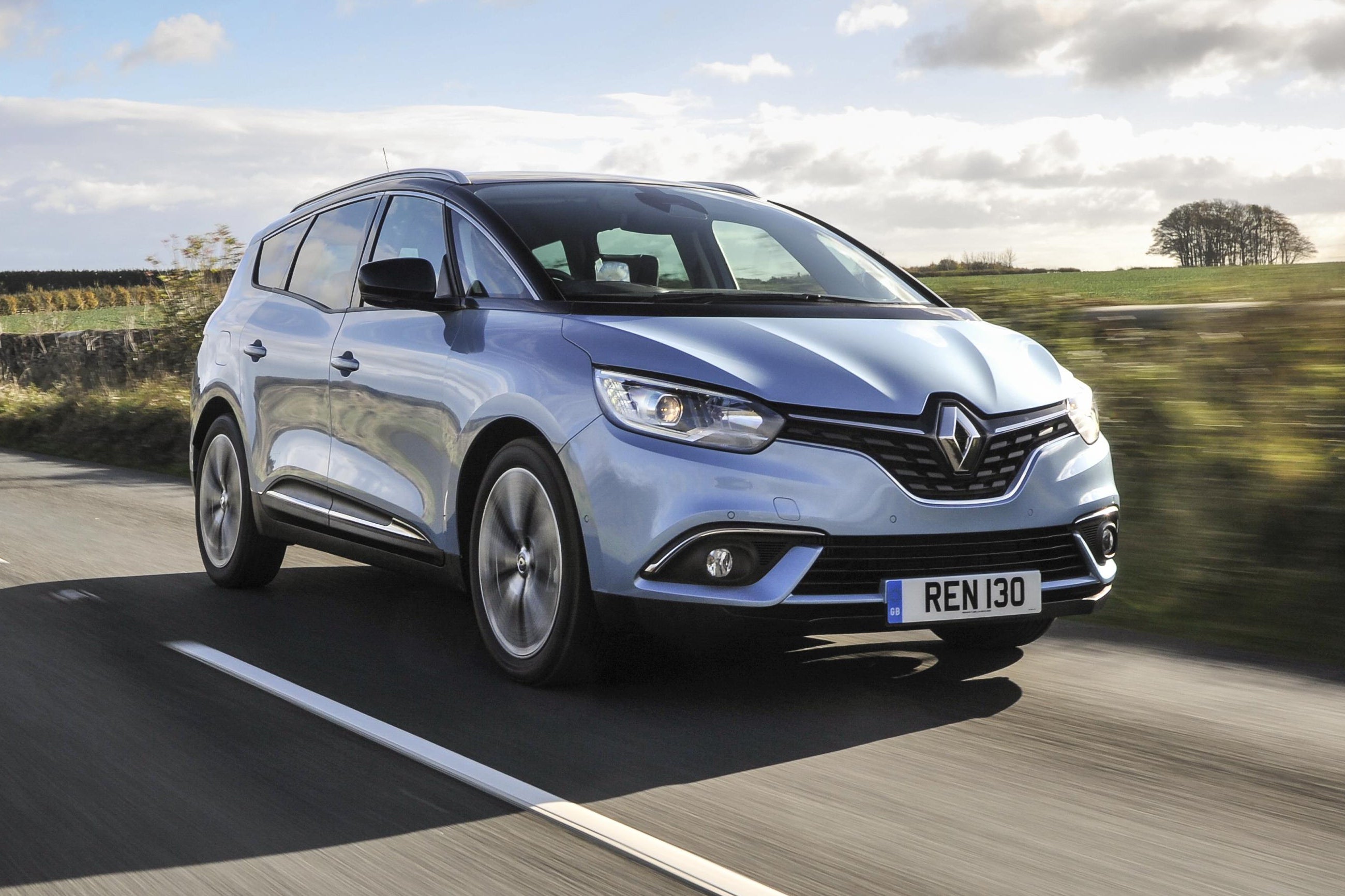Renault Grand Scenic (2016-2020) Review
Written by Andrew Brady
Quick overview
Pros
- Classy styling that stands out from the crowd
- Upmarket interior with family-friendly features
- Long list of standard equipment
Cons
- More a 5+2 MPV than a true seven-seater
- Large alloy wheels upset the ride quality
- Infotainment screen looks the part, but fails to impress
Overall verdict on the Renault Grand Scenic
"In this Renault Grand Scenic review we're looking at one of the last genuine MPVs on the market from the manufacturer that started the whole segment in the first place. Finally discontinued in 2020, the Renault Grand Scenic at least proved there was still value in the template; with a flexible cabin, surprisingly stylish exterior, a big boot and good equipment levels, it should be enough to make you think twice before choosing a default SUV instead."
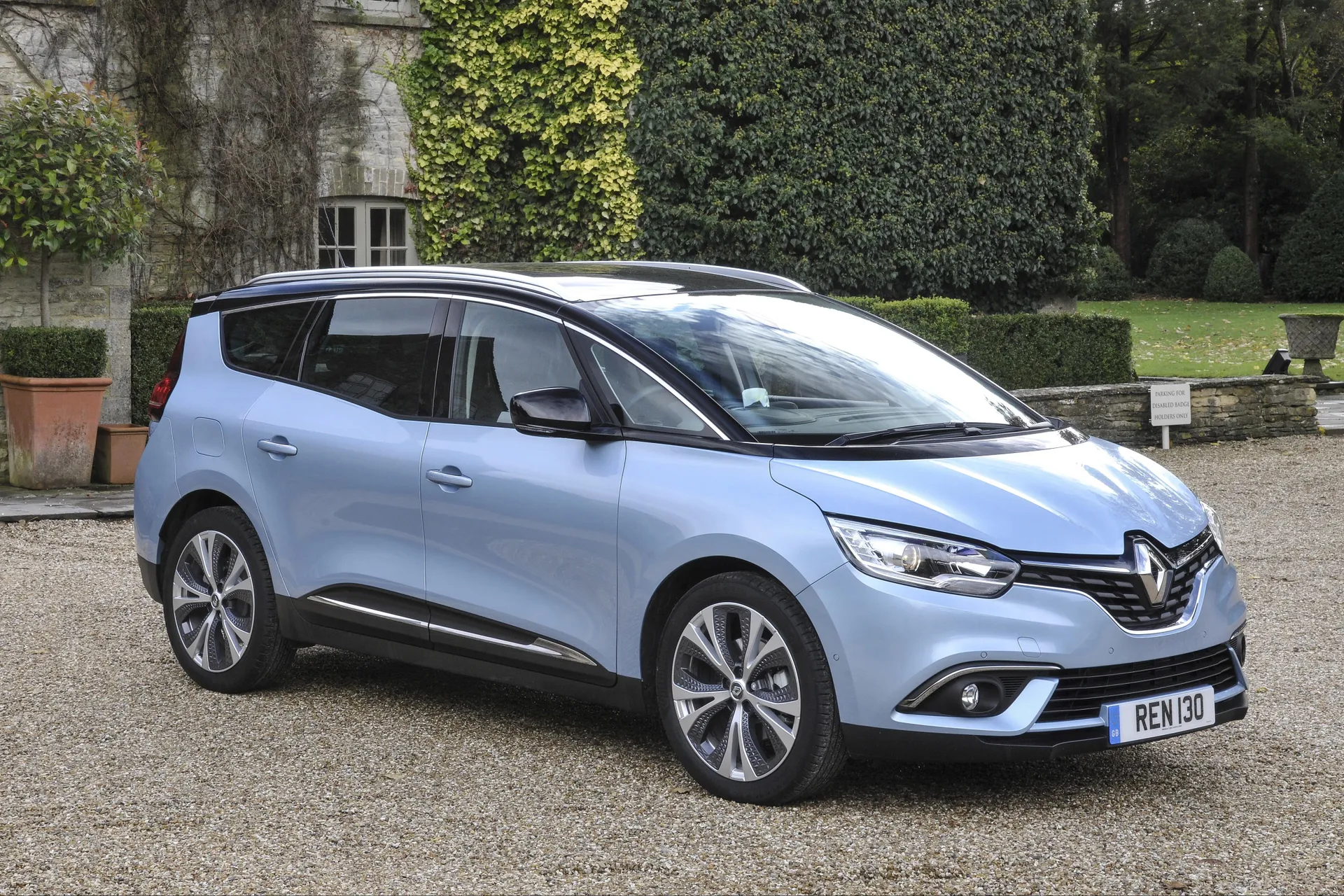
You can still buy a seven-seat MPV these days, but your choice is exceptionally limited if you want to buy new. SUVs have taken over to the point where the sector is almost extinct, but you don't have to rewind too far to benefit from the last models to compete in this segment. Renault has history here, with the Espace kicking off the whole thing way back in 1984. Tastes might have changed but people still need to cram lots of people and luggage into the smallest footprint possible, which is where MPVs still have an edge.
In common with many of its rivals, the Renault Grand Scenic would be best described as a ‘5+2’ MPV, rather than a full seven-seater. The third row is a little tight, even for children, but the seats are fine for occasional use.
When viewed as a five-seat MPV, it’s easy to make a case for the Renault Grand Scenic. The dramatic styling is matched by an upmarket cabin, although it lacks the wow-factor of the Peugeot 5008.
It’s also incredibly well-equipped, with even the entry-level Play trim offering a level of specification that would be mid-range in some rivals. The flagship Signature trim edges the Renault Grand Scenic into premium territory, with a comprehensive list of equipment including a large portrait-style touchscreen.
There are just two engines in later models: a 1.3-litre TCe 140 petrol and a 1.8-litre Blue dCi 120 diesel. Both offer enough power to push the Grand Scenic along at a brisk rate, but the diesel just edges the petrol for torque and its ability to cope with the strains of seven people and their luggage.
Not that you will get much luggage in the boot when all seven seats are occupied. It’s no wonder Renault offered an optional roof box, which increases the overall luggage capacity by as much as 500 litres. That’s like having an old Citroen C5 estate mounted on the roof.
Up front, the Iconic and Signature trim levels feature a clever sliding centre console, which is one reason why you might want to upgrade from the Play version. We’d argue the Renault Grand Scenic doesn’t offer the best cabin storage, though, as the glovebox is too small and the door pockets are too narrow.
Although it can’t match the Ford C-MAX and S-MAX for dynamic appeal, the Renault Grand Scenic offers a mature and sophisticated driving experience. There’s a bit of lean when cornering, but this is countered by excellent grip. Unfortunately, there’s little in the way of feedback through the steering, so it’s best to adopt a smooth and relaxed driving style.
The 20-inch wheels upset the ride quality, but while the suspension is firm, it’s never uncomfortable. Only letting the train take the strain is more relaxing on a cross-continental trip.
Put simply, the Renault Grand Scenic is a great looking, well-equipped and practical MPV. Let your friends follow the crowd by opting for an SUV – the smart money goes on Renault’s big wheels.
Looking for a used car for sale? We've got 100s of Renault Approved Used Cars for Sale for you to choose from, including a wide range of Renault Grand Scenic cars for sale.
Is the Renault Grand Scenic right for you?
If you can’t beat ‘em... join ‘em. Rather than fight the rise of the seven-seat SUV, Renault decided to fuse two body styles in the creation of the Grand Scenic. It’s still a people carrier, but the styling is more akin to something you’d find on an SUV.
As a result, it’s one of the best looking cars in its class, with a classy, flexible and upmarket cabin to match. You’ll have to make one or two sacrifices in terms of outright practicality, but as a 5+2 MPV, there’s a lot to like about the Renault Grand Scenic.
What’s the best Renault Grand Scenic model/engine to choose?
Early versions of the Renault Grand Scenic came with 1.2 or 1.3 TCe engines with outputs from 115PS to 140PS, or 1 .6 dCi in 110PS and 130PS flavours. Skip the lower power versions - not that there will be many on the used market anyway - as they don't have enough pulling power to deal with big loads of people and luggage.
Later models came with just the choice of the 140PS petrol or a 1.5-litre 120PS diesel. The 1.3-litre turbocharged TCe 140 petrol engine does a remarkably good job, offering plenty of punch and strong refinement.
The 1.5-litre turbocharged Blue dCi 120 just edges the petrol engine, offering more torque and improved efficiency. On a family holiday with a boot full of luggage, you’ll be glad you opted for the diesel.
All versions offer a generous level of standard equipment, but we’d recommend the mid-range Iconic trim for the best balance of price and toys. Front and rear parking sensors and the sliding centre console are just two reasons why we’d upgrade from the entry-level Play trim.
The flagship Signature offers a premium take on the MPV formula, but it was quite an expensive upgrade when new. It could be worth finding a used example, mind.
What other cars are similar to the Renault Grand Scenic?
Because the Renault Grand Scenic straddles the MPV and SUV segments, it faces a fight from two sides. It can’t offer the outright practicality and flexibility of the Citroen Grand C4 SpaceTourer, SEAT Alhambra or Volkswagen Sharan, as those MPVs offer genuine seating for seven people.
This leaves the Grand Scenic to compete against rivals like the Peugeot 5008, SEAT Tarraco and Skoda Kodiaq. The seating arrangement in these cars is best described as ‘5+2’ – five great seats and a couple of cheap seats at the very back.
If you require all seven seats more often than not, the Renaut Grand Scenic isn’t for you. However, for occasional use it’s perfectly fine.
Comfort and design: Renault Grand Scenic interior
"Renault knows a thing or two about building family cars. The original Espace popularised the concept of a mass-market people carrier, while the Megane Scenic was the first of a new breed of mini-MPVs."
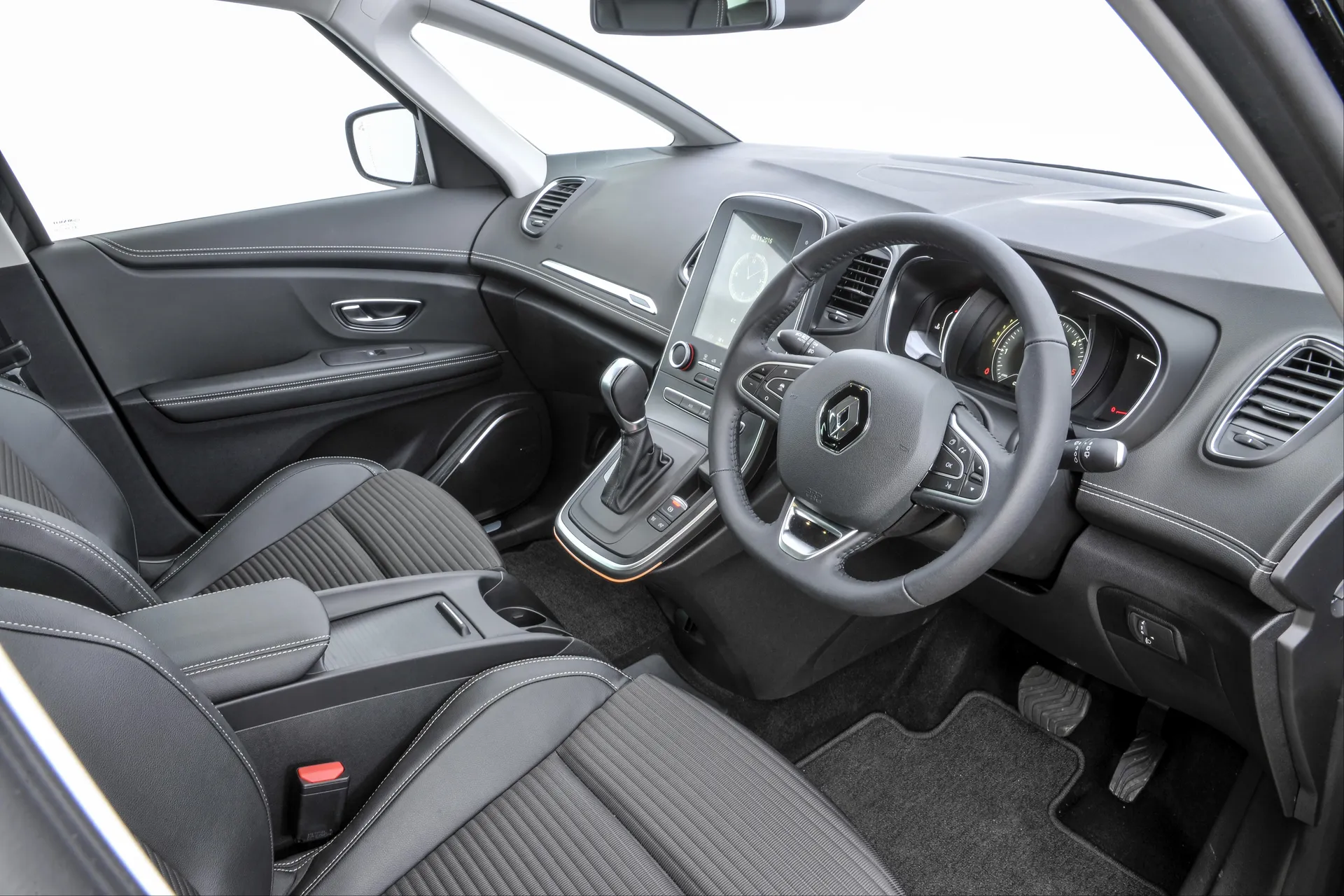
The cabin in the Renault Grand Scenic is a successful marriage of form and function. The interior is focused around a touchscreen infotainment system, which is positioned in the centre of an uncluttered dashboard. There’s nothing outlandish about the design – it just works.
It might be a cliché to say that the Renault Grand Scenic was designed from the inside out, but that’s the impression you get. Iconic and Signature models offer a useful sliding centre console that can be configured for front or rear occupants.
You sit high, which provides a commanding view of the road ahead, with visibility aided by a three-piece windscreen. Indeed, the raised driving position is more akin to an SUV, with the driver’s seat offering height and lumbar adjustment. You can travel across Europe in supreme comfort. Still want that TGV train ticket, etc?
All versions of the Renault Grand Scenic come with dual-zone climate control, tinted windows, reading lights for second-row occupants and electric rear windows. So you won’t hear too many complaints from your passengers.
Quality and finish
The materials used in the cabin feel robust, which is arguably the most important thing in a family car. You don’t want things to start falling apart after a few trips to the seaside or a dozen school runs.
Perceived quality is good, but some of the plastics positioned lower down feel cheap to touch. The lesson here: don’t touch them. That sliding console, while clever, is also a little plasticky, with the impression that it won’t last the lifetime of the car.
Upgrading to the Signature trim adds a touch of class. Features include extra comfort front headrests, LED reading lights for all three rows of seats, synthetic and dark carbon cloth upholstery, stitch detailing for the dashboard and upper door panels, ambient lighting and extra tinting for the rear and tailgate glass.
The feeling of quality across the range is enhanced by a synthetic leather steering wheel, along with a leather and satin chrome gear knob. For maximum indulgence, an optional Leather Pack Premium on the Signature trim adds full leather and electric adjustment to the front seats. It also includes underseat storage for the front passenger seat.
Infotainment: Touchscreen, USB, nav and stereo in the Renault Grand Scenic
The Play and Iconic models have a seven-inch touchscreen infotainment screen, with DAB digital radio, Bluetooth, Apple CarPlay and Android Auto. It certainly looks the part, but it’s not the most intuitive system and some of the menus can be painfully slow to load.
You get the same issues with the 8.7-inch portrait touchscreen on the Signature trim, but the problems are counterbalanced by 3D mapping. You get a colour head-up display for safer driving, too.
Iconic and Signature models also boast an Arkamys Auditorium premium sound system with six speakers, an extra USB port in the front and two USB ports in the back. All models get voice control and steering wheel-mounted controls.
Music fans should consider upgrading to the excellent Bose premium audio system, which comprises 11 speakers, a digital amplifier and a subwoofer. The option is available on the Signature trim.
All models get a configurable seven-inch digital display ahead of the driver. A range of information is displayed, but while the system is good, it can’t match the brilliance of Audi’s Virtual Cockpit.
Space and practicality: Renault Grand Scenic boot space
As a five-seater, the Renault Grand Scenic feels incredibly spacious. Three adults can sit comfortably in the second row of seats, with plenty of headroom throughout the cabin, even with a panoramic sunroof fitted.
Things are less positive in the third row, where the space is severely restricted unless you slide the second row of seats right forward. Even then, the third row is best suited to small children or occasional use.
It’s also a bit of a struggle to get into the third row, although it helps if you slide the second row of seats. The Signature model boasts a ‘One-Touch Folding’ system, which allows you to lower the rear seats via the touchscreen, or by using the controls in the boot. The result is a fully flat floor.
With all seven seats in use, the boot offers a mere 233 litres of space, but this increases to 596 litres in five-seat mode. With all rear seats folded down you’re presented with van-like proportions, with loading aided by a large tailgate and a low lip. An optional Holiday Pack comprises roof bars and a roof box, with the capacity extendable from 300 to 500 litres.
The second row bench features a 60/40 split, so it’s not possible to fold each seat down individually. That said, you can fold the far left seat on the second row, together with the left seat on the back row if you want to carry a long, narrow load. In this configuration the Renault Grand Scenic would be a five-seater.
The sliding centre console is a neat touch. In the forward position, the console is used as an armrest, with rear seat passengers presented with a storage bin, two USB ports and a 12-volt socket. Unfortunately, it obscures the front cupholders, which are too small for all but the slimmest cups and bottles.
The glovebox and front door pockets are also a little on the small side, but the Renault Grand Scenic redeems itself with underfloor storage in the back, a multi-position boot floor, front seats with rear-mounted storage pockets and a removable boot floor. Iconic and Signature models boast 56.9 litres of cabin storage space.
It’s worth noting that the Renault Grand Scenic features a pair of standard rear doors. While this is true of many cars, they can’t beat the convenience of sliding doors, especially when loading children into car seats. There are three ISOFIX child car seat mounting points: two in the second row and one on the front passenger seat.
The Renault Grand Scenic dimensions are 4634mm long, 2128mm wide and 1660mm tall.
Handling and ride quality: What is the Renault Grand Scenic like to drive?
"The Renault Grand Scenic occupies the middle ground between a comfortable cruiser and a dynamic hero. The best of both worlds or a compromised driving experience? It depends on which way you look at it."
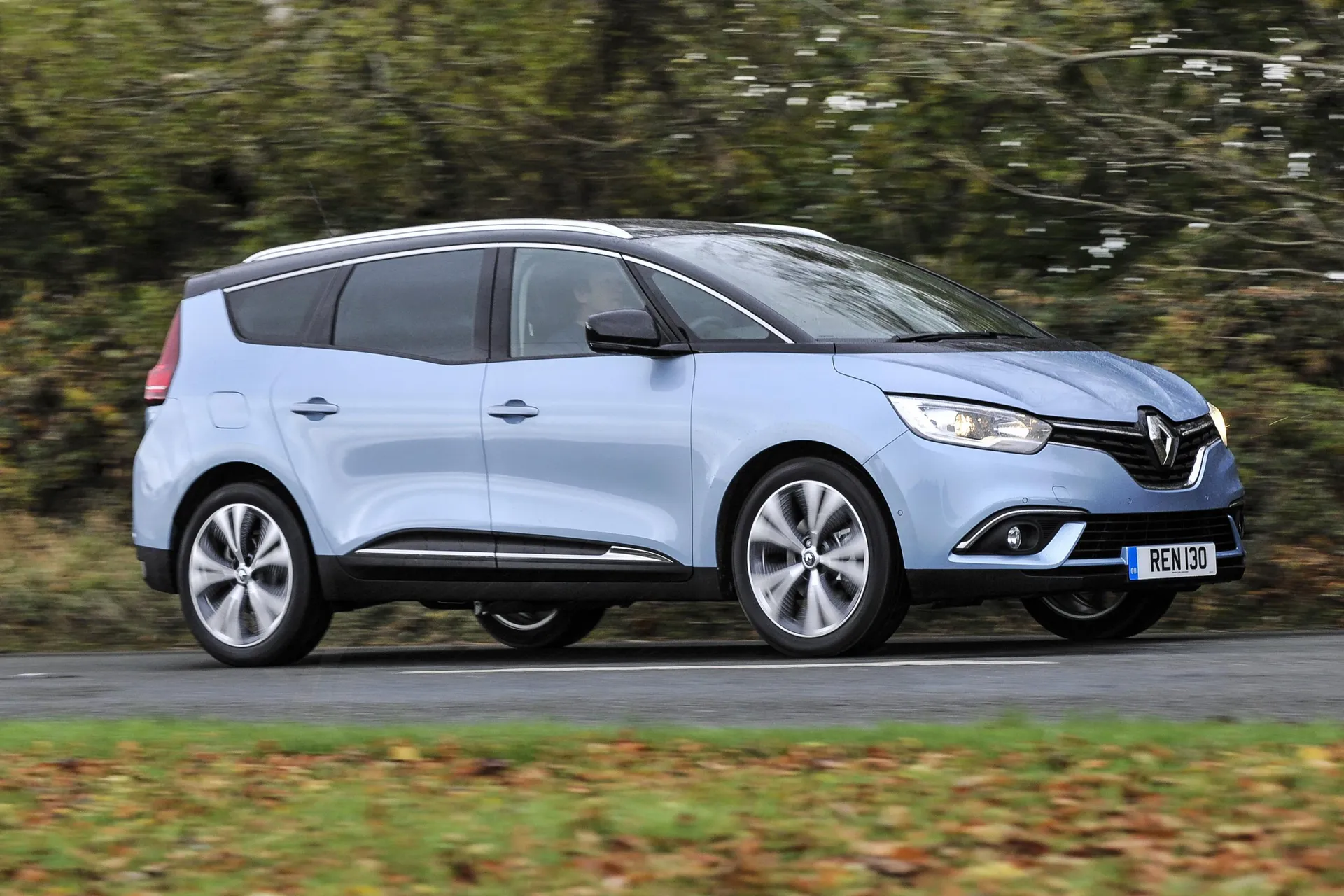
Those 20-inch alloy wheels might look the part, but they serve to make the car unsettled over rough surfaces, delivering a slightly firmer ride than you’d expect from a French MPV. That said, it’s not as bumpy as it could be, so credit goes to Renault for creating a relatively composed ride without resorting to air suspension.
You’re unlikely to drive the Renault Grand Scenic in the way you would something wearing a Renault Sport badge. This is just as well, as any attempt at enthusiastic cornering is rewarded with a fair amount of body-roll. There’s enough grip, but the steering doesn’t inspire enough confidence and there’s a feeling of detachment from the road.
Because of the design of the bonnet, it’s also difficult to pinpoint the front corners of the car, which makes it tricky to position the Renault Grand Scenic on the road. This, combined with the poor rearward visibility, make it difficult to park. The front and rear parking sensors (standard on Iconic and Signature) will come in handy here.
Alternatively, hands-free parallel, perpendicular and angled parking is available as an option on the Signature model. Renault says parking ‘will all be fun from now on’. That might be a stretch, but it’s a useful feature.
What engines and gearboxes are available in the Renault Grand Scenic?
Although there were five diesels and two petrols available at launch, latterly the Renault Grand Scenic was powered by a choice of two engines, both of which can be paired to a six-speed manual or seven-speed dual-clutch automatic gearbox.
The 1.3-litre turbocharged TCe 140 petrol engine does a remarkably good job of propelling the Grand Scenic along at a brisk rate. With 140PS and 240Nm of torque, the Grand Scenic completes the 0-62mph dash in 10.3 seconds, before hitting a top speed of 119mph.
The 1.5-litre turbocharged Blue dCi 120 diesel engine offers 120PS, but a punchier 300Nm of torque at 1,750rpm. As a result, it’s the engine of choice when travelling with a cabin full of passengers and a boot loaded with luggage.
Although the automatic transmission blunts the performance and takes the edge off the fuel economy, it seems to suit the laid-back and relaxed nature of the Grand Scenic. A manual gearbox feels out of place in an MPV with premium aspirations.
If you intend to spend most of your time in the city, opt for the petrol engine. It’s cheaper to fill the tank, you won’t have to worry about diesel particulate filter (DPF) issues, and diesel cars are becoming increasingly unwelcome in European towns and cities.
Refinement and noise levels
Whether you opt for the petrol or diesel, you’ll soon find the Renault Grand Scenic is a refined companion. The cabin is well insulated from wind and road noise, with the engines settling to a quiet idle on a long run. It helps that both engines are four-cylinder units, rather than the three-cylinder units favoured by some rivals.
If anything, the notchy and lacklustre manual gearbox lets the side down, which is another reason to choose the superior seven-speed automatic.
Safety equipment: How safe is the Renault Grand Scenic?
Renault was the first company to be awarded five stars for occupant protection by safety organisation Euro NCAP. It has been producing similar results ever since.
Although the Grand Scenic hasn’t been crash tested by Euro NCAP, it shares much in common with the smaller Renault Scenic. In 2016, the Scenic received a five-star rating, with scores of 90% for adult occupant protection, 82% for child occupant protection, 67% for pedestrian safety, and 59 percent for safety assist systems.
All Grand Scenic models feature multiple airbags, automatic headlights and wipers, cruise control with speed limiter, hill start assist, LED indicators in the door mirrors, LED rear lights, auto-locking doors at 6mph, rear parking sensors, tyre inflation kit and Renault’s Visio System. This comprises lane departure warning, traffic sign recognition and automatic high and low beam.
Iconic and Signature models boast front and rear parking sensors and fatigue alert, while the Signature also benefits from a rear-view camera. Full LED headlights and a blind spot warning system are optional on the Signature trim.
A Safety Pack Premium is also available on the Signature model. It features adaptive cruise control, lane keeping assist and safe distance warning. A space-saving spare wheel is optional across the Grand Scenic range.
MPG and fuel costs: What does the Renault Grand Scenic cost to run?
"Predictably, the Blue dCi 120 diesel offers the best fuel economy, offering between 50.4mpg and 51.4mpg when paired with a manual gearbox."

These claimed figures drop to 46.3mpg to 47.1mpg in the automatic version. Predictably, the Blue dCi 120 diesel offers the best fuel economy, offering between 50.4mpg and 51.4mpg when paired with a manual gearbox. These figures drop to 46.3mpg to 47.1mpg in the automatic version.
The Play TCe 140 petrol has the potential to deliver 40.9mpg, although this drops to 39.2mpg to 39.8mpg when the engine is mated to the automatic.
It’s worth remembering that diesel fuel costs more at the pumps. You should also avoid the diesel version of the Grand Scenic if most of your journeys are over short distances and around town.
How reliable is a Renault Grand Scenic?
The Renault Grand Scenic scored a mediocre 9.00 out of 10 for reliability in the HonestJohn.co.uk Satisfaction Survey, which is somewhere in the middle of Renaults in general but also a little worse than some key rivals. Recalls have been issued for the Renault Grand Scenic, with issues related to brakes and exhausts, so check to make sure any car you look at has been repaired if required.
As a brand Renault finished a lowly 27th out of 30 manufacturers overall in the same survey.
Insurance groups and costs
By slotting into insurance group 14, the Play Blue dCi 120 and Iconic Blue dCi 120 models will be the cheapest to insure. With a group rating of 17, the Signature TCe 140 will be the most expensive, but there’s not a significant difference across the range.
For some context, the Citroen Grand C4 SpaceTourer slots into groups 17 to 30, making it more expensive to insure. In fact, the Grand Scenic is likely to be cheaper to insure than some versions of the smaller and far less practical Renault Captur. The groups for the compact crossover range from 8 to 21.
VED car tax: What is the annual road tax on a Renault Grand Scenic?
Renault Grand Scenics registered before April 2017 cast cost as little as £20 per year for the 1.5 dCi 110 versions, all the way up to £135 for the 140PS TCe with the automatic transmission.
Cars registered after this date will attract the flat rate of £165.
How much should you be paying for a used Renault Grand Scenic?
"Prices start from around £14,000 for an early example of the current shape Renault Grand Scenic. This is between £2,000 and £3,000 more than a run-out version of the old Grand Scenic of the same vintage."
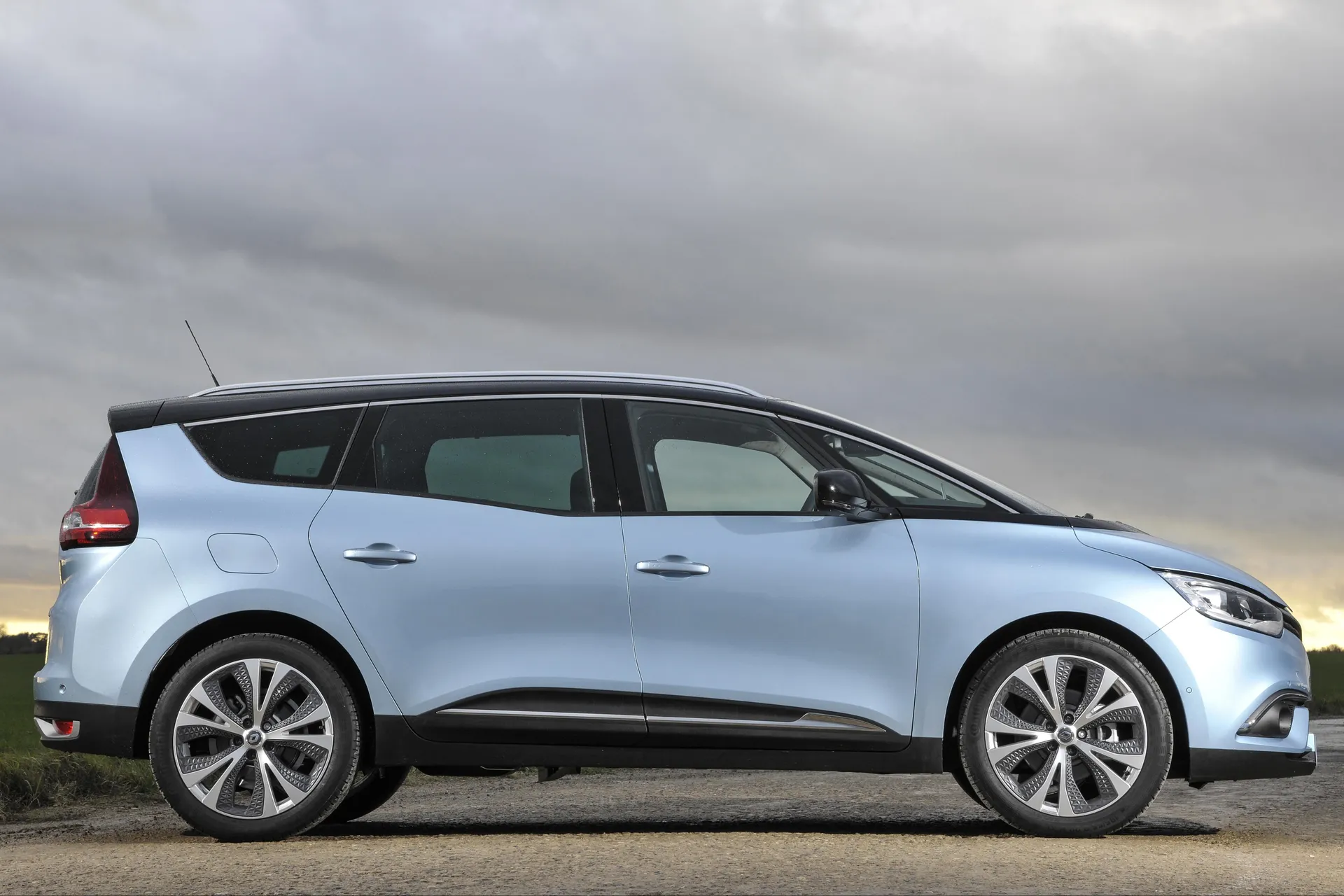
It’s worth noting that cars registered up to and including 31 January 2018 are covered by a four-year/100,000-mile warranty. All Renaults ordered and registered from 1 February 2018 until 17 December 2019 get cover for three years and 60,000 miles.
A five-year/100,000-mile warranty was announced for all new Renaults at the end of 2019. This means a Grand Scenic registered from 18 December 2019 will be covered for five years. You will pay upwards of £20,000 for a 2020 model, but you have the reassurance of the car being under manufacturer warranty until 2025.
Trim levels and standard equipment
Even the entry-level Renault Grand Scenic Play trim offers a generous level of standard equipment. A seven-inch touchscreen, Apple CarPlay and Android Auto connectivity, dual-zone climate control, automatic headlights and wipers, a keycard, 20-inch alloy wheels, cruise control, rear parking sensors and seven seats represent just a small part of a comprehensive list.
We’d be tempted to upgrade to the Renault Grand Scenic Iconic trim, if only for the benefit of front and rear parking sensors, the 3D sound system, extra USB ports and the sliding centre console. The flagship Renault Grand Scenic Signature features bespoke 20-inch alloy wheels, a head-up display, a rear-view camera, a panoramic sunroof, interior LED lighting, an 8.7-inch portrait display, 3D navigation, puddle lighting, ambient lighting and one-touch folding rear seats.
When you consider the list of goodies on the Signature trim, it’s easier to justify the £3,000 jump from the Play to the flagship model. If the sums work out for you, a Grand Scenic Signature is a fine way to travel.
Ask the heycar experts: common questions
Is the Renault Grand Scenic a seven-seater?
Are Renault Grand Scenics reliable?
Is the Renault Scenic a good car?
Get our latest advice, news and offers
Keep me updated by email with the latest advice, news and offers from heycar.
By submitting you agree to our privacy policy
